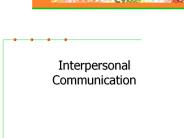Communicating For Effectiveness - PowerPoint PPT Presentation
1 / 17
Title:
Communicating For Effectiveness
Description:
Explain how perception, inferences, language, and status can ... Calm, peaceful, serene. Dignified, stately. Color. Red. Blue. Orange. Blue. Red. Blue. Purple ... – PowerPoint PPT presentation
Number of Views:47
Avg rating:3.0/5.0
Title: Communicating For Effectiveness
1
Chapter 11
- Communicating For Effectiveness
2
Learning Objectives
- Describe how technology impacts communication.
- Describe how the communication process works.
- Discuss how to choose the appropriate
communication medium. - Explain how perception, inferences, language, and
status can lead to communication breakdown. - Identify eight ways to overcome barriers to
communication and achieve effective
communication. - Describe how the four steps in the communication
process can help improve a managers
communication skills. - Describe the importance of using simple
repetitive language, empathy, and body language
in achieving effective communication.
3
Learning Objectives (contd.)
- Discuss ten guidelines for developing effective
listening habits. - Identify four ways for improving writing skills.
- Explain the four parts of PLAN (purpose,
logistics, audience, nonverbal communication) for
improving speaking skills. - Explain how to manage stress more effectively.
4
Technologys Impact on Communication
- Cell Phones
- Camera Phones
- Wi-Fi Networks
- Global Positioning Systems
- Patterns of Communication
- Organization Structure
5
The Communication Process
- Communication is the process of transmitting
meanings from sender to receiver. - Encoding is translating a message into an
intelligible code. - Decoding is interpretation of the message by the
receiver.
6
Steps in the Encoding Process
- The sender thinks through the ideas to be
communicated. - The sender translates these ideas into some code
or symbol.
7
Figure 11.1 - The Communication Process in Action
8
The Association of Moods With Colors (Selected
Based on Table 11.2)
- Mood
- Exciting, stimulating
- Secure, comfortable
- Distressed, disturbed, upset
- Tender, soothing
- Protective, defending
- Calm, peaceful, serene
- Dignified, stately
- Color
- Red
- Blue
- Orange
- Blue
- Red
- Blue
- Purple
9
Information Richness
- is the potential information-carrying capacity
of data. - Four Factors
- Feedback
- Channel
- Type of communication
- Language source
10
Barriers to Communication
- Perception a persons view of reality
- Inference an assumption made by the receiver of
a message - Language
- Status a persons relative rank
11
Achieving Effective Communication
- Knowing the steps in the communication process
- Using simple, repetitive language
- Using empathy
- Understanding body language
- Learning how to receive and give feedback
- Developing effective listening habits
- Improving writing and speaking skills
- Understanding gender differences
12
Steps in the Communication Process
- Attention the overcoming of message competition
- Understanding involves comprehension of the
message - Acceptance means compliance
- Action requires that the receiver does what was
expected
13
Empathy
- means putting oneself in another persons place.
14
Body Language
- Eye movement
- Posture
- Touch
- Physical Location
15
Effective Listening Habits
- Ask questions that will help provide feedback and
increase understanding - Remain objective
- Empathize and try to see things from that
individuals point of view
16
Skill Work
- Improve Your Writing Skills
- Improve Your Speaking Skills
- PLAN
17
Key Terms in the Chapter
- Communication
- Encoding
- Decoding
- Perception
- Inference
- Status
- Attention
- Understanding
- Acceptance
- Action
- Empathy
- Proxemics
- Information richness
- Linguistic style































